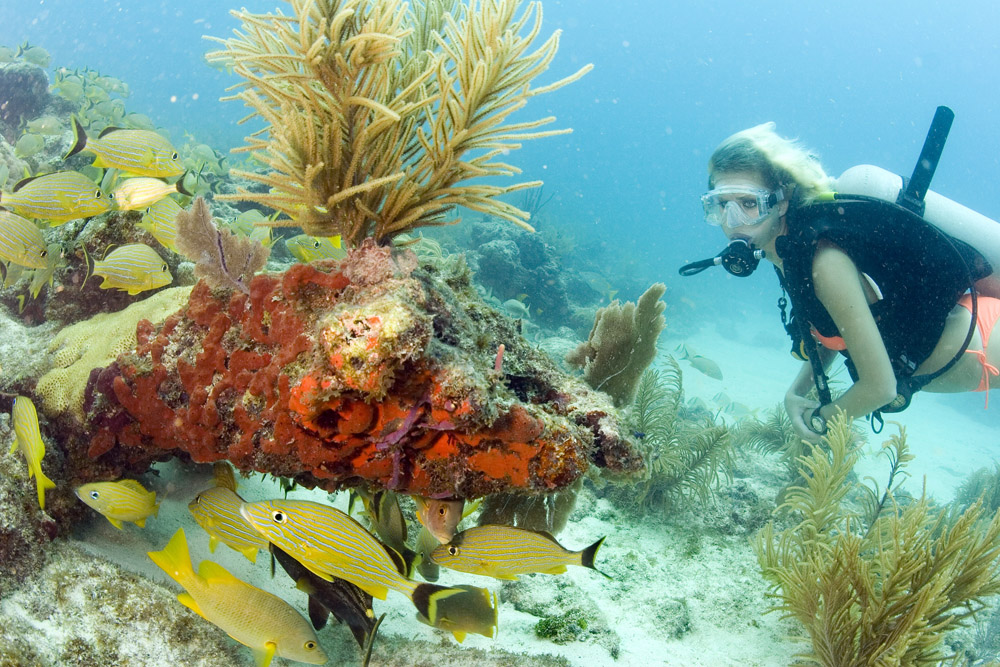Famed around the globe, the clear warm waters of the Florida Keys attract almost 800,000 scuba and snorkel aficionados annually. There’s no better place to learn how to get “up close and personal” with the undersea environment.

For both kids and grownups, exploring the marine environment surrounding the Florida Keys is a must during a visit to the island chain. (Photo by Stephen Frink)
The combination of vivid coral reefs teeming with exotic sea creatures, plus a wealth of professional snorkel and dive operators, means the Keys are a ready-made vacation paradise for those ready to jump in the water and start exploring, even as first-timers.
Snorkeling requires just a mask to see underwater, a snorkel for breathing and fins for propulsion — all easily rented or affordably purchased — and can be experienced with minimal instruction.
Scuba diving is more complex, requiring sophisticated equipment and instruction by certified professionals. Instruction generally lasts from one day for an introductory lesson to five days for comprehensive open-water certification.
To maintain the Keys’ status as the world’s most popular dive destination, the offshore environment — including the continental United States’ only living coral barrier reef — has been the focus of conservation efforts for more than a generation.
The Florida Keys National Marine Sanctuary, established in 1990, includes the coastal waters of the entire island chain — from northernmost Key Largo southwest to the Dry Tortugas, a group of tiny islands 70 miles west of Key West.
Whether you’re indulging in scuba or snorkel, the Keys’ coral reefs provide spectacular scenery and an exhilarating encounter with nature.

The unparalleled Looe Key Reef is an area of the Florida Keys National Marine Sanctuary about 6 miles south of Big Pine Key.
Five sites in particular are included in the “Become a Reef Explorer” dive and snorkel program. The program spotlights Keys reefs with a specially created souvenir journal, designed for first-timers, families and fun-loving outdoor enthusiasts of all experience levels who want to log dives or snorkels while exploring the region’s remarkable reefs.
Key West’s largest protected coral reef is Western Sambos, part of an ecological reserve created in 1997. Several other extensive shallow reefs off Key West, including Eastern Dry Rocks, Rock Key and Sand Key, are abundant in corals, gorgonians and fish, and range from 5 to 45 feet in depth.
Looe Key Reef in the Lower Keys is an area of the sanctuary approximately 6 miles south of Big Pine Key. A complete reef ecosystem is found here between 20 and 40 feet deep, from a rubble ridge of ancient fossilized corals to a reef flat composed of turtle grass and a fore reef made up of large star and brain corals. Farther out is American Shoals, favored for its lighthouse structure, corals and abundant marine life.
Marathon’s notable shallow patch reefs and spur-and-groove formations include Sombrero Reef, marked by a large lighted tower. Watch spotfin butterflyfish circle in a courting dance, French angelfish nip and peck at reef plants, huge schools of grunts slide back and forth in a gentle tidal surge or a stingray scour the sandy bottom for a snack.

Snorkeler Katherine Wieland examines the “Christ of the Abyss” statue off Key Largo. (Photo by Stephen Frink, Florida Keys News Bureau)
At Crocker Reef off Islamorada, depths range from 30 to 60 feet and its south end slopes along a wall of spur-and-groove coral formations and coral mounds that extends for more than 400 feet, with gradual depths to nearly 80 feet. It’s common to see large schools of blue striped grunts, large groupers, spotted eagle rays, nurse sharks, sea turtles, green moray eels, barrel sponges and sea fans.
In the waters off Key Largo surrounding John Pennekamp Coral Reef State Park, which is incorporated in the Florida Keys National Marine Sanctuary, lies Dry Rocks. At this spot, the 9-foot bronze “Christ of the Abyss” statue rests in approximately 20 feet of water surrounded by large brain, staghorn and elkhorn coral formations — as well as a 4-foot barracuda that seems to enjoy being photographed.
Overall, the Keys boast an unparalleled variety of marine life, an abundance of fish species and consistently clear, warm waters to suit virtually every ocean enthusiast.
For more information about dive and snorkel opportunities around the island chain, visit fla-keys.com/diving/.

